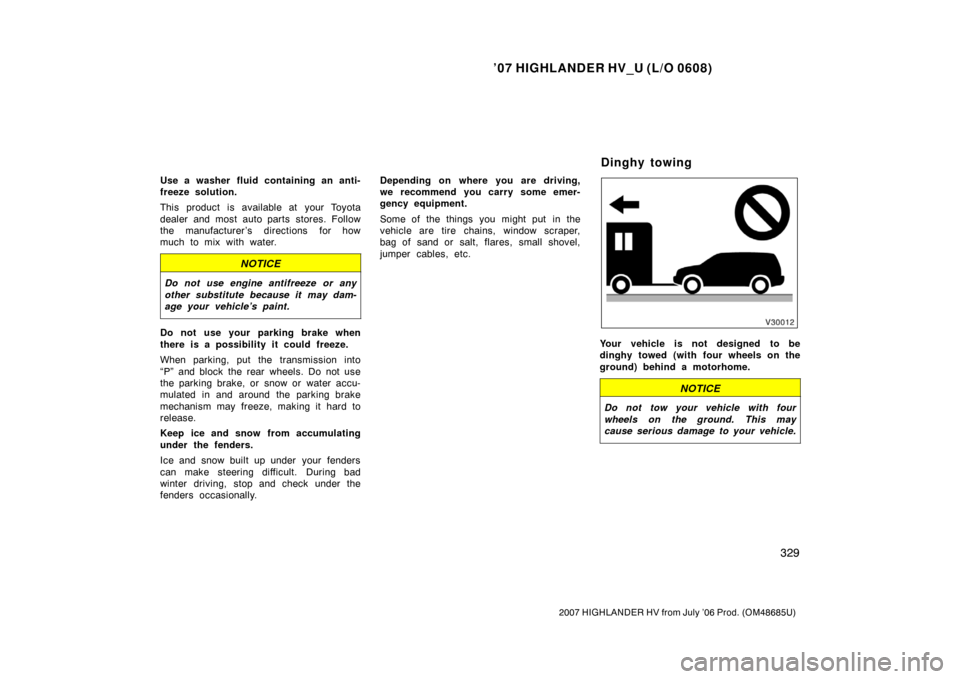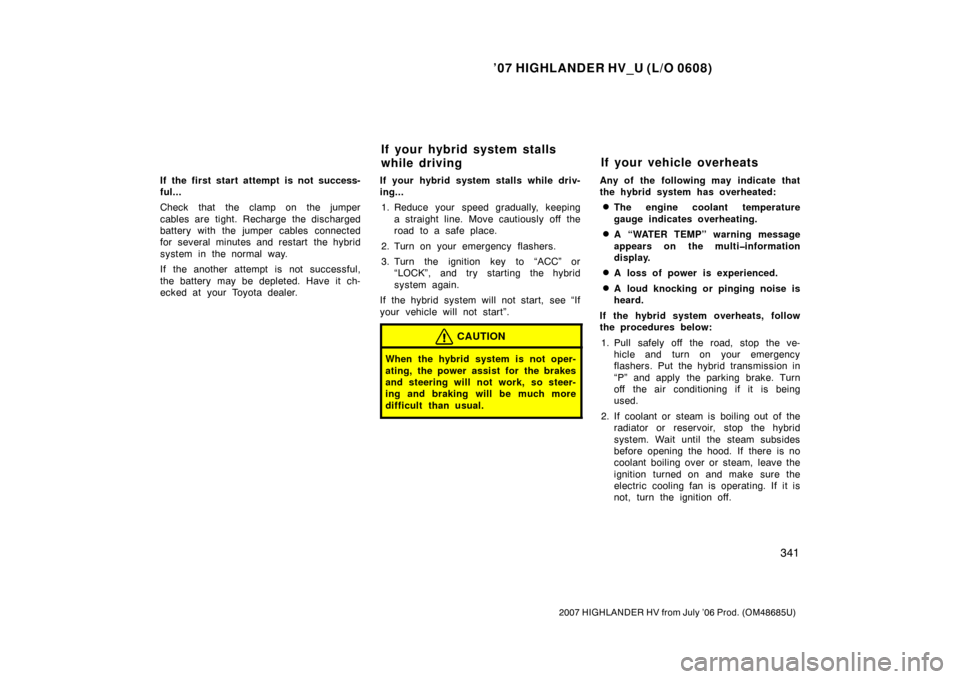Page 341 of 436

’07 HIGHLANDER HV_U (L/O 0608)
329
2007 HIGHLANDER HV from July ’06 Prod. (OM48685U)
Use a washer fluid containing an anti-
freeze solution.
This product is available at your Toyota
dealer and most auto parts stores. Follow
the manufacturer ’s directions for how
much to mix with water.
NOTICE
Do not use engine antifreeze or any
other substitute because it may dam-
age your vehicle’s paint.
Do not use your parking brake when
there is a possibility it could freeze.
When parking, put the transmission into
“P” and block the rear wheels. Do not use
the parking brake, or snow or water accu-
mulated in and around the parking brake
mechanism may freeze, making it hard to
release.
Keep ice and snow from accumulating
under the fenders.
Ice and snow built up under your fenders
can make steering difficult. During bad
winter driving, stop and check under the
fenders occasionally.Depending on where you are driving,
we recommend you carry some emer-
gency equipment.
Some of the things you might put in the
vehicle are tire chains, window scraper,
bag of sand or salt, flares, small shovel,
jumper cables, etc.Your vehicle is not designed to be
dinghy towed (with four wheels on the
ground) behind a motorhome.
NOTICE
Do not tow your vehicle with four
wheels on the ground. This may
cause serious damage to your vehicle.
Dinghy towing
Page 346 of 436

’07 HIGHLANDER HV_U (L/O 0608)
334
2007 HIGHLANDER HV from July ’06 Prod. (OM48685U)
�Remember that when making a turn,
the trailer wheels will be closer than
the vehicle wheels to the inside of the
turn. Therefore, compensate for this by
making a larger than normal turning
radius with your vehicle.
�Crosswinds and rough roads will ad-
versely affect handling of your vehicle
and trailer, causing sway. Pay attention
to the rear from time to time to pre-
pare yourself for being passed by large
trucks or buses, which may cause your
vehicle and trailer to sway. If swaying
happens, firmly grip the steering wheel
and reduce speed immediately but
gradually. Never increase speed. Steer
straight ahead. If you make no extreme
correction with the steering or brakes,
the vehicle and trailer will stabilize.
�Be careful when passing other ve-
hicles. Passing requires considerable
distance. After passing a vehicle, do
not forget the length of your trailer and
be sure you have plenty of room be-
fore changing lanes.
�Because of the added load of the trail-
er, your vehicle’s engine may overheat
on hot days (at temperatures over
30�C [85 �F]) when going up a long or
steep grade with a trailer. If the engine
coolant temperature gauge indicates
overheating, immediately turn off the air
conditioning (if in use), pull off the road
and stop in a safe spot. Refer to “If
your vehicle overheats” on page 341 in
Section 4.
�Always place wheel blocks under both
the vehicle and trailer wheels when
parking. Apply the parking brake firmly.
Put the transmission in “P”. Avoid park-
ing on a slope with a trailer, but if it
cannot be avoided, do so only after
performing the following:
1. Apply the brakes and hold.
2. Have someone place wheel blocks un- der both the vehicle and trailer wheels.
3. When the wheel blocks are in place, release your brakes slowly until the
blocks absorb the load.
4. Apply the parking brake firmly.
5. Shift into “P” and turn off the hybrid system. When restarting out after parking on a
slope:
1. With the transmission in the “P” posi- tion, start the hybrid system. Be sure
to keep the brake pedal depressed.
2. Shift into gear.
3. Release the parking brake and brake pedal and slowly pull or back away
from the wheel blo cks. Stop and apply
your brakes.
4. Have someone retrieve the blo cks.
Page 353 of 436

’07 HIGHLANDER HV_U (L/O 0608)
341
2007 HIGHLANDER HV from July ’06 Prod. (OM48685U)
If the first start attempt is not success-
ful...
Check that the clamp on the jumper
cables are tight. Recharge the discharged
battery with the jumper cables connected
for several minutes and restart the hybrid
system in the normal way.
If the another attempt is not successful,
the battery may be depleted. Have it ch-
ecked at your Toyota dealer.If your hybrid system stalls while driv-
ing...
1. Reduce your speed gradually, keeping a straight line. Move cautiously off the
road to a safe place.
2. Turn on your emergency flashers.
3. Turn the ignition key to “ACC” or “LOCK”, and try starting the hybrid
system again.
If the hybrid system will not start, see “If
your vehicle will not start”.
CAUTION
When the hybrid system is not oper-
ating, the power assist for the brakes
and steering will not work, so steer-
ing and braking will be much more
difficult than usual.
Any of the following may indicate that
the hybrid system has overheated:
�The engine coolant temperature
gauge indicates overheating.
�A “WATER TEMP” warning message
appears on the multi�information
display.
�A loss of power is experienced.
�A loud knocking or pinging noise is
heard.
If the hybrid system overheats, follow
the procedures below: 1. Pull safely off the road, stop the ve- hicle and turn on your emergency
flashers. Put the hybrid transmission in
“P” and apply the parking brake. Turn
off the air conditioning if it is being
used.
2. If coolant or steam is boiling out of the radiator or reservoir, stop the hybrid
system. Wait until the steam subsides
before opening the hood. If there is no
coolant boiling over or steam, leave the
ignition turned on and make sure the
electric cooling fan is operating. If it is
not, turn the ignition off.
If your hybrid system stalls
while driving If your vehicle overheats
Page 355 of 436

’07 HIGHLANDER HV_U (L/O 0608)
343
2007 HIGHLANDER HV from July ’06 Prod. (OM48685U)
CAUTION
When jacking, be sure to observe
the following to reduce the possi-
bility of death or serious injury:
�Follow jacking instructions.
� Do not put any part of your
body under the vehicle sup-
ported by the jack. Otherwise,
personal injury may occur.
� Do not start the hybrid system
while your vehicle is supported
by the jack.
� Stop the vehicle on a level firm
ground, firmly set the parking
brake and put the transmission
in “P”. Block the wheel diago-
nally opposite to the one being
changed if necessary.
�Make sure to set the jack prop-
erly in the jack point. Raising
the vehicle with jack improper-
ly positioned will damage the
vehicle or may allow the ve-
hicle to fall off the jack and
cause personal injury.
� Never get under the vehicle
when the vehicle is supported
by the jack alone.
� Use the jack only for lifting
your vehicle during wheel
changing.
� Do not raise the vehicle with
someone in the vehicle.
� When raising the vehicle, do
not place any objects on top
of or underneath the jack.
� Raise the vehicle only high
enough to remove and change
the tire.NOTICE
Do not continue driving with a
deflated tire. Driving even a
short distance can damage a
tire and wheel beyond repair.
Page 357 of 436
’07 HIGHLANDER HV_U (L/O 0608)
345
2007 HIGHLANDER HV from July ’06 Prod. (OM48685U)
To remove the jack, rotate the jack
joint by hand until the jack becomes
free.To store the jack, ro tate the jack joint
until the jack is firmly secured.
After storing the jack, make sure it is
securely held by the tightening strap.
This prevents the jack from flying for-
ward during a collision or sudden
stop.To detach the spare tire:
1. Remove the inside spare tire cov- er by turning it counterclockwise.
Page 358 of 436
’07 HIGHLANDER HV_U (L/O 0608)
346
2007 HIGHLANDER HV from July ’06 Prod. (OM48685U)
2. Remove the cover as shown in theillustration.3. Put the adapter socket (for remov-ing a spar e tir e) on the spar e tir e
clamp bolt.4. Threading the jack handle throughthe adapter socket, turn the jack
handle counterclockwise. Contin-
ue until the spare tire is lowered
completely to the ground.
Page 359 of 436
’07 HIGHLANDER HV_U (L/O 0608)
347
2007 HIGHLANDER HV from July ’06 Prod. (OM48685U)
5. Pull out the spare tire and standit up against the bumper.6. Remove the hold ing br ac k et and
the spare tire cover.2. Block the wheel diagonally op- posite the flat tire to keep the
vehicle from rolling when it is
jacked up.
When blocking the wheel, place a
wheel block in front of one of the front
wheels or behind one of the rear
wheels.
—Blocking the wheel
Page 360 of 436
’07 HIGHLANDER HV_U (L/O 0608)
348
2007 HIGHLANDER HV from July ’06 Prod. (OM48685U)
3. Loosen all the wheel nuts.
Always loosen the wheel nuts before
raising the vehicle.
Turn the wheel nuts counterclockwise
to loosen. To get maximum leverage,
fit the wrench to the nut so that the
handle is on the right side, as shown
above. Grab the wrench near the end
of the handle and pull up on the han-
dle. Be careful that the wrench does
not slip off the nut.
Do not remove the nuts yet—just un-
screw them about one −half turn.
CAUTION
Never use oil or grease on the
bolts or nuts. The nuts may loose
and the wheels may fall off,
which could cause a serious ac-
cident.
4. Position the jack at the correct
jack point as shown.
Make sure the jack is positioned on
a level and solid place.
—Loosening wheel nuts —Positioning the jack